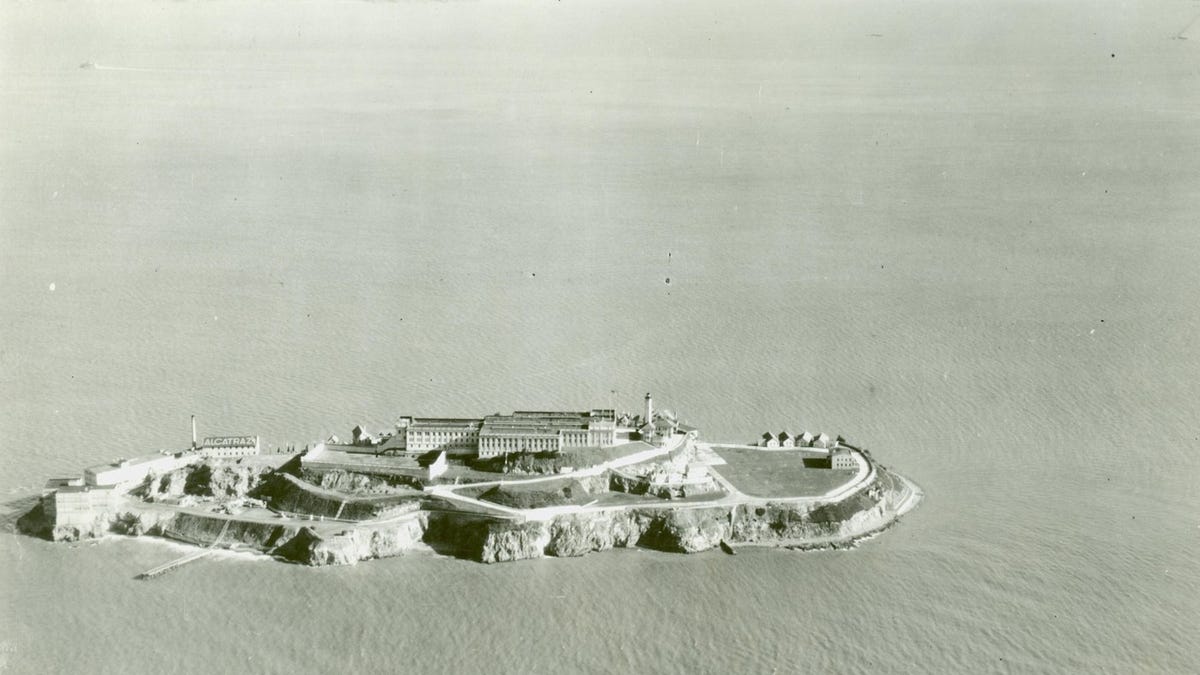Could coconuts reveal the secrets of the great Alcatraz escape?
As if the 1962 breakout from the "inescapable" prison wasn't already nuts, researchers now hope to find the truth with help from fruit.

An aerial view of Alcatraz, aka "The Rock," when it was still operating as a maximum-security prison.
Researchers from the Netherlands have been working for a few years now to solve a mystery that's persisted for over half a century: Could the three inmates who famously escaped from Alcatraz prison in 1962 actually have survived the trip across the San Francisco Bay? The researchers' computer model says it's possible, and now they're performing an experiment at the scene of the breakout to try and determine the final fates of John Anglin, Clarence Anglin and Frank Morris.
Morris and the Anglin brothers attempted their daring escape with some serious MacGyver skills, decades before those were even a thing. They crafted dummy heads to fool guards, tunneled through the walls of a prison deemed inescapable and then disappeared into the treacherous dark of the bay aboard a raft made of raincoats with homemade paddles.
Earlier this month, scientists from the University of Delft went to Alcatraz and deployed a small fleet of coconuts to see where the strong currents in the bay might carry the tropical fruit under identical tidal conditions. Of course, the coconuts weren't using any prison-made paddles, but they were equipped with technologies that had yet to be invented in 1962: GPS and a 3G data connection to track their every move, bob and drift.
The three escapees were never seen again, leaving generations to wonder if they'd managed to make it to the mainland and disappear or were instead swept out with the tide to their demise in the Pacific Ocean.
Olivier Hoes and colleague Rolf Hut first began looking into the mystery a few years ago by creating a computer model to simulate the tides on the night the inmates escaped: June 11, 1962.
"As soon as we had our model running, we saw that if you leave (Alcatraz Island) too early, you end up in the Pacific," Hoes explained. "But if you leave exactly around 11:30 (p.m.), then you are at slack tide near the Golden Gate, which gives you the opportunity to paddle to the shore, either on the south or the north side."
Specifically, the model predicts that if the escapees timed it right, they should have wound up washing ashore at Horseshoe Bay, near the northern end of the Golden Gate Bridge. Notably, an old episode of "Mythbusters" attempted to re-create the escape and came up with roughly the same result.
But the model also shows that timing is everything. The trio is thought to have hit the water sometime between 10 p.m. and midnight -- if they left much earlier than 11:30, they're likely to have been pulled under the bridge to the ocean. If they got a late departure, they may have been sucked back toward the south, perhaps making it possible to land on Treasure Island some 2 miles (3.2 kilometers) away.
As it turns out, the evening of Wednesday, April 12, 2017, exactly replicated the tide conditions of the night the inmates escaped. So last Wednesday, the scientists took a boat out to Alcatraz Island and let the coconuts go at different times after fitting them with flashing LED lights and surrounding them with floating GPS trackers.
Coconuts bust outta the joint: Will the husky escapees make it to safety in Horseshoe Bay? Or wind up in the belly of a great white shark out in the Pacific?
"We're going to be tracking, using these asset trackers, the exact location of 20 of these drifters as they go out toward the Golden Gate Bridge; hopefully some of them get back," researcher Rolf Hut said just before boarding the boat from San Francisco last week.
Trackers from Particle, a company that makes Internet of Things software and hardware, were implanted inside the coconuts and can relay data via a cellular connection. Hut said his team used the same type of trackers on a different project that studied how rivers merge in Myanmar.
Over the coming weeks, the research team will analyze all the data they gathered from their coconuts' long swim in the bay. Their final conclusions will be revealed on a Science Channel program set to air later this year.
Meanwhile, if you happen to spot a suspicious-looking coconut with a busted GPS tracker anywhere in the San Francisco Bay Area, please do approach it, as it's likely not armed and dangerous, and we know of a few scientists who'd probably like to know where it is.
Crowd Control: A crowdsourced science fiction novel written by CNET readers.
CNET en Español: Get all your tech news and reviews in Spanish.

